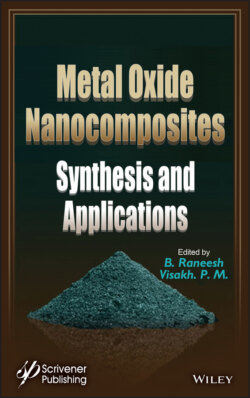Читать книгу Metal Oxide Nanocomposites - Группа авторов - Страница 19
1.7 Semiconducting Metal Oxides for Photocatalytic and Gas Sensing Applications
ОглавлениеOne of the vital classes of the water contaminations is ‘dyes’. Worldwide, more than 0.75 million tons of synthetic dyes are fabricated every year for the most part for use in the leather goods, plastics, textile, modern painting, products, electronic sectors and cosmetics [123–126]. About 1–20% of the total worldwide production of dyes is lost in the dyeing process and released into the environment as textile effluent. The effect of these dyes on the earth is a noteworthy concern as a result of the conceivably carcinogenic properties of these compounds. The wastewater which is colored due to the presence of these dyes can block both oxygen dissolution and sunlight penetration, which are necessary for aquatic life [127–129]. Apart from the aesthetic point of view, dyes are undesirable because they can affect the living creatures in water, when discharged as effluent into the environment. Industrial effluents containing synthetic dyes diminish light penetration in rivers and other water bodies and in this manner influence the photosynthetic activity of aquatic flora, thereby severely affecting the food source of aquatic organisms [130, 131]. Colored effluents from textile, dye, paper and pulp industries are somewhat hard to treat as they contain compounds with complex aromatic structures, rendering them quite difficult to treat [132, 133]. Oxidation of organic compounds proceeds through a number of free radical reactions, producing a large number of intermediates, which in turn, undergo oxidative cleavage, ultimately resulting in the formation of carbon dioxide, water and inorganic ions [134].
In the photocatalytic degradation of pollutants, when the reduction process of oxygen and the oxidation of pollutants do not advance simultaneously, there is an electron accumulation in the CB, thereby causing an increase in the rate of recombination of and . An important step in photocatalysis reactions is light absorption in the catalyst particle and to design properly a photo-reactor, the kinetics of the photo reaction should be known. Most kinetic models used in photocatalysis are based on the Langmuir–Hinshelwood (L–H) model [135]. This model explains the kinetics of reactions that occur between two adsorbed species, a free radical and an adsorbed substrate, or a surface-bound radical and a free substrate. The initial rate of substrate varies proportionally with the catalyst surface coverage and the adsorption equilibrium of the substrate follows a Langmuir isotherm. The experimentally determined dark adsorption coefficients are reported to differ from those determined during illumination [136]. Many techniques are used for the purpose of gas detection and each technique has certain advantages and disadvantages as well. Depending on the nature of material, each sensor is known to be sensitive to a group of a family of gases and similarly each gas can be detected by different materials [137]. Gas sensors have a great influence in many important areas namely environmental monitoring, domestic safety, public security, automotive applications, air-conditioning in aeroplanes, spacecrafts, etc. Semiconducting metal oxides possess a broad range of electronic, chemical, and physical properties that are often highly sensitive to changes in their chemical environment [138, 139]. Many scientists and engineers have studied metal oxide thin films as electronic materials due to their semiconducting behavior, structural simplicity and low cost. Numerous researchers have shown that the reversible interaction of gas with the surface of material is the characteristic of conductometric semiconducting metal oxide gas sensors. This reaction can be influenced by many factors, including internal and external causes, such as the natural properties of base materials, surface area, microstructure of sensing layers, surface additives, temperature, humidity, etc. [140].
